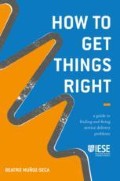Abstract
The motto “no hire, no fire” becomes an absolute must to make brainpower concentrate on value-added tasks that sustain their employability and the company’s competitive edge. Our companies understand and act upon the need to address efficiency before they even consider getting new people on board. Technology becomes one of the great allies in freeing up brainpower from nonadded value tasks.
Access this chapter
Tax calculation will be finalised at checkout
Purchases are for personal use only
Notes
- 1.
Key located at the top of the keyboard that refreshes the screen and folders.
- 2.
Reasoning formed by two premises and a conclusion that is the logical outcome of those premises. I formulate the two premises here, and the conclusion I leave to readers.
- 3.
Moreover, it is euphonious (pleasing to the ear), very much after the fashion of my ancestor…
- 4.
Undertaking a transformation plan for efficiency without using the term is somewhat suggestive.
- 5.
But the basic principles were stuck to. After all, the CEO owns the strategy and knows where the company has to go.
- 6.
This is very often the case with brains that sense they have an operational problem, but do not have the conceptual framework to really understand it and act. And when they are given the framework, they grasp it with untold strength and throw themselves into deploying it.
- 7.
And from the accepted definition that knowledge is the ability to solve problems.
- 8.
The following chapter deals with the concept of unlocking ability, so here we shall just mention it.
- 9.
Obviously, after analyzing whether they are right. At times, informal rules are right for a small group, but not for the service in general. And that may not be formalized. Only what adds value to providing the service may be formalized. The rest must be overhauled.
- 10.
In the next chapter, when we delve deeper into primary and secondary tasks, we shall see how Hephaestus wanted to unbundle knowledge types in as much detail as possible. Depending on each company’s taste. What is important is their use in improving efficiency.
- 11.
From “I know more and you less”, and all of us must know a lot. Completely wrong. The right level is needed to tackle the problem arising.
- 12.
Readers should note that knowledge stock is matched, not people. I may have physical people, but not the knowledge stock needed to solve the problems that come my way.
- 13.
Unexpected absences, for example.
- 14.
When a task is primary and when secondary may be defined in each company according to its Promise and circumstances. The basic idea is: “primary”, immediate response time (zero minutes). The rest, “secondaries”.
- 15.
As we shall see in Chap. 6.
- 16.
We shall look more deeply into that in Chap. 6.
- 17.
There are various types of creativity (Boden 1991). The combinatory type is the simplest, the exploratory type arises in the exploration process, and the transformation type breaks molds.
- 18.
Some of them call it being brazen (dictionary definition: brazen, defiant, insolent, disrespectful), and I take it to mean defiant.
- 19.
This chapter’s conceptual appendix contains the SPDM forms for doing this.
- 20.
Documentation found in individual computers, post-its, and so on. It is usually a lot and often very important.
- 21.
E2E, end to end.
- 22.
Videos must be no more than two minutes long.
- 23.
We shall look more closely at pills in Chap. 6.
- 24.
That does not mean implementing them will be easy. It takes a lot of determination to see it through and people falter. It is a change in operating culture that must be consolidated and that, always, takes perseverance, constancy and backing from senior management.
- 25.
Every company has them. There is no need to confront them; they must be managed and engaged. They are smart and contribute. And always, at some stage, they realize what they are missing. Perseverance and patience is the way to deal with them.
- 26.
They never say NO. They always seek twists and turns and must be allowed to wander.
Bibliography
Boden, M. A. (1991). The creative mind: Myths and mechanisms (1st ed.). New York: Basic Books. (First edition published 1990 by George Weidenfeld and Nicolson Ltd.)
Author information
Authors and Affiliations
Corresponding author
Chapter 2: Conceptual Appendix
Chapter 2: Conceptual Appendix
-
I.
Spotting knowledge

-
II.
VOC


-
III.
Operations rules

Rights and permissions
Copyright information
© 2019 The Author(s)
About this chapter
Cite this chapter
Muñoz-Seca, B. (2019). No Hire, No Fire: Address Sustainable Efficiency Before Headcount. In: How to Get Things Right. IESE Business Collection. Palgrave Macmillan, Cham. https://doi.org/10.1007/978-3-030-14088-5_2
Download citation
DOI: https://doi.org/10.1007/978-3-030-14088-5_2
Published:
Publisher Name: Palgrave Macmillan, Cham
Print ISBN: 978-3-030-14087-8
Online ISBN: 978-3-030-14088-5
eBook Packages: Business and ManagementBusiness and Management (R0)

